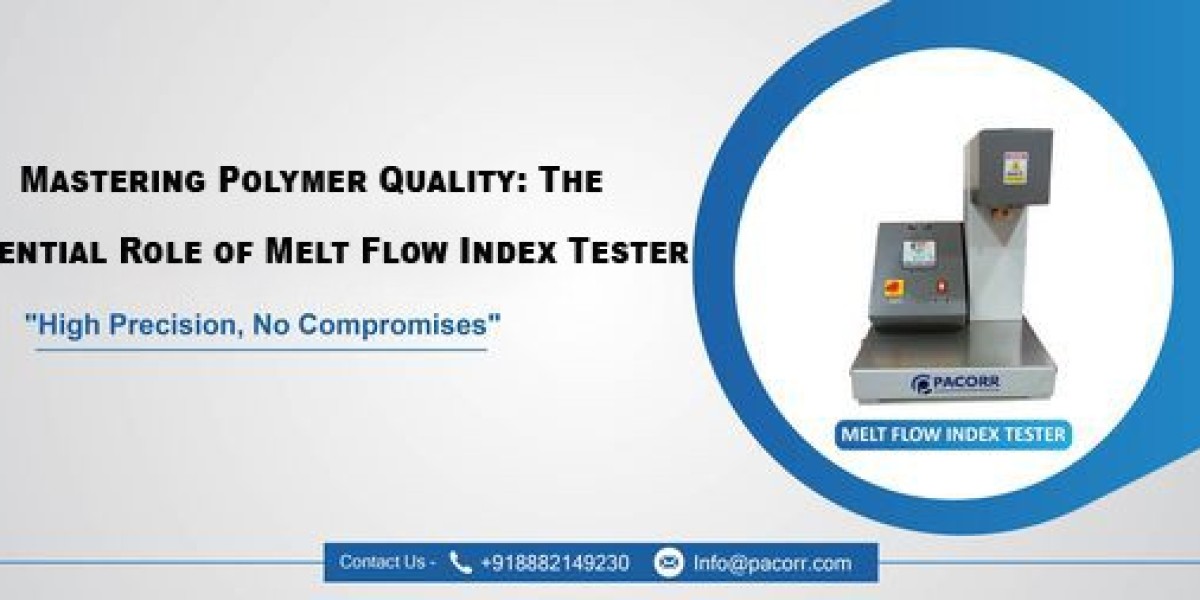What is the Melt Flow Index?
The Melt Flow Index Tester quantifies the ease of flow of melted plastic. It is defined as the mass of polymer, in grams, that flows in ten minutes through a capillary of a specified diameter and length under a designated load and temperature. The MFI value is crucial in understanding the polymer's viscosity, impacting both its processing and end-use performance.
The Importance of Melt Flow Index Testing
· Quality Control: Consistency in polymer properties is critical for maintaining product quality. The MFI test ensures that each batch meets the required standards, preventing defects and ensuring uniformity in the final products.
· Material Selection: Different applications require polymers with specific flow characteristics. The MFI test aids manufacturers in selecting the most suitable material for a particular application, ensuring optimal performance.
· Process Optimization: By understanding the flow properties of polymers, manufacturers can optimize processing conditions such as temperature, pressure, and cooling rates, leading to improved efficiency and reduced waste.
· Compliance with Standards: Many industries have stringent standards that polymers must meet. The MFI test is a standardized method used to certify that materials comply with these regulations.
How Does a Melt Flow Index Tester Work?
The Melt Flow Index Tester operates by heating a polymer sample to a specified temperature and then forcing it through a capillary die under a predetermined load. The mass of the extrudate collected over a set period is weighed, and the MFI value is calculated. The test procedure typically involves the following steps:
1. Sample Preparation: A specific amount of polymer is prepared and placed in the barrel of the MFI Tester.
2. Heating: The barrel is heated to the test temperature, ensuring the polymer reaches a molten state.
3. Loading: A specified weight is placed on the piston to apply pressure on the molten polymer.
4. Extrusion: The polymer is extruded through the capillary die, and the extrudate is collected for a set period.
5. Weighing and Calculation: The extrudate is weighed, and the MFI is calculated based on the mass of the extrudate, the duration of the test, and the applied load.
Applications of Melt Flow Index Testing
Melt Flow Index Tester finds widespread use in various industries, including:
· Automotive Industry: Ensures that plastic components meet the required performance standards for durability and functionality.
· Packaging Industry: Helps in selecting materials with appropriate flow characteristics for manufacturing containers, films, and other packaging products.
· Consumer Goods: Ensures the quality and consistency of plastic products such as toys, household items, and electronic housings.
· Medical Devices: Critical in ensuring that medical-grade plastics meet stringent quality standards for safety and performance.
· Construction: Assists in the selection and quality control of plastic materials used in building and construction applications.
Advances in Melt Flow Index Testing
With advancements in technology, modern Melt Flow Index Tester come equipped with features that enhance accuracy, ease of use, and data management. Some of these advancements include:
1. Digital Controls and Displays: Modern MFI Testers feature digital controls and displays for precise temperature control and real-time monitoring of the test process.
2. Automated Testing: Automated systems reduce human error and increase repeatability by automating the loading, heating, and extrusion processes.
3. Data Management Systems: Advanced MFI Testers are equipped with data management systems that allow for easy recording, analysis, and reporting of test results.
4. Enhanced Safety Features: Modern testers incorporate safety features such as automatic shut-off and temperature control to ensure safe operation.
Choosing the Right Melt Flow Index Tester
Selecting the appropriate Melt Flow Index Tester depends on several factors, including the type of polymers being tested, the required accuracy, and the specific industry standards. Here are some key considerations:
· Test Requirements: Determine the specific testing needs, such as the type of polymer and the range of MFI values to be measured.
· Accuracy and Precision: Ensure the tester provides the necessary accuracy and precision for your quality control processes.
· Ease of Use: Look for features that simplify the testing process, such as user-friendly interfaces, automated functions, and easy maintenance.
· Data Management: Consider the data management capabilities, especially if you need to integrate the tester with other quality control systems or require detailed reporting.
· Compliance with Standards: Ensure the MFI Tester complies with relevant industry standards and regulations to guarantee reliable and consistent results.
Conclusion
The Melt Flow Index Tester is an indispensable tool in the plastics industry, providing valuable insights into the flow properties of polymers. By ensuring consistency, aiding in material selection, optimizing processing conditions, and ensuring compliance with standards, the MFI test helps manufacturers produce high-quality polymer products. As technology advances, Melt Flow Index Tester continue to evolve, offering greater accuracy, efficiency, and ease of use. For manufacturers looking to maintain stringent quality control and improve their production processes, investing in a reliable Melt Flow Index Tester is essential
By understanding the significance of Melt Flow Index testing and utilizing advanced testing equipment, manufacturers can enhance their product quality, meet industry standards, and stay competitive in the ever-evolving market of polymer products.
FAQ Section
Q1: What is the Melt Flow Index Tester?
A1: The Melt Flow Index Tester is a measure of the ease of flow of melted plastic, defined as the mass of polymer in grams that flows in ten minutes through a capillary under a specified load and temperature.
Q2: Why is MFI testing important?
A2: MFI testing is crucial for quality control, material selection, process optimization, and compliance with industry standards, ensuring consistent and high-quality polymer products.
Q3: How does a Melt Flow Index Tester work?
A3: The MFI Tester heats a polymer sample to a specified temperature, applies a load, and forces the molten polymer through a capillary die. The mass of the extrudate collected over a set period is weighed to calculate the MFI.
Q4: In which industries is MFI testing used?
A4: MFI testing is used in automotive, packaging, consumer goods, medical devices, and construction industries to ensure the quality and performance of plastic materials.
Q5: What are some advancements in MFI testing technology?
A5: Advancements include digital controls and displays, automated testing systems, data management systems, and enhanced safety features, improving accuracy, efficiency, and ease of use.
Q6: How can manufacturers benefit from using MFI Testers?
A6: Manufacturers can benefit from improved product quality, optimized processing conditions, and compliance with standards, leading to increased efficiency and reduced waste in production processes.
For more information about our Melt Flow Index Tester and other testing solutions, visit us at Pacorr.com








